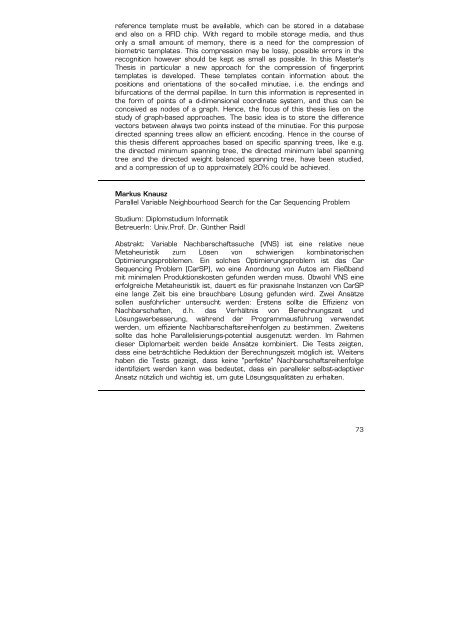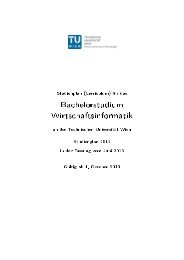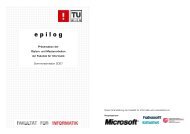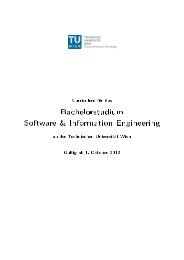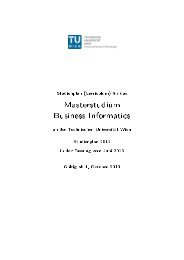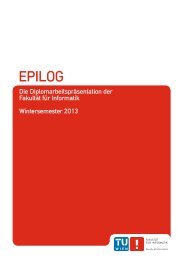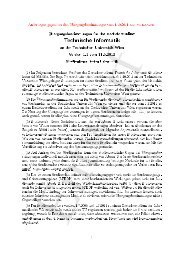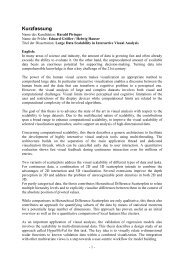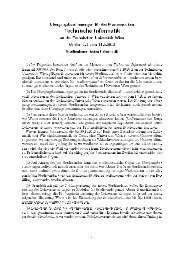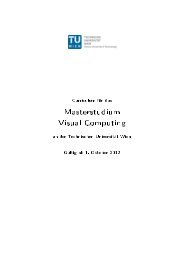e p i l o g - Fakultät für Informatik, TU Wien
e p i l o g - Fakultät für Informatik, TU Wien
e p i l o g - Fakultät für Informatik, TU Wien
Sie wollen auch ein ePaper? Erhöhen Sie die Reichweite Ihrer Titel.
YUMPU macht aus Druck-PDFs automatisch weboptimierte ePaper, die Google liebt.
eference template must be available, which can be stored in a database<br />
and also on a RFID chip. With regard to mobile storage media, and thus<br />
only a small amount of memory, there is a need for the compression of<br />
biometric templates. This compression may be lossy, possible errors in the<br />
recognition however should be kept as small as possible. In this Master's<br />
Thesis in particular a new approach for the compression of fingerprint<br />
templates is developed. These templates contain information about the<br />
positions and orientations of the so-called minutiae, i.e. the endings and<br />
bifurcations of the dermal papillae. In turn this information is represented in<br />
the form of points of a d-dimensional coordinate system, and thus can be<br />
conceived as nodes of a graph. Hence, the focus of this thesis lies on the<br />
study of graph-based approaches. The basic idea is to store the difference<br />
vectors between always two points instead of the minutiae. For this purpose<br />
directed spanning trees allow an efficient encoding. Hence in the course of<br />
this thesis different approaches based on specific spanning trees, like e.g.<br />
the directed minimum spanning tree, the directed minimum label spanning<br />
tree and the directed weight balanced spanning tree, have been studied,<br />
and a compression of up to approximately 20% could be achieved.<br />
Markus Knausz<br />
Parallel Variable Neighbourhood Search for the Car Sequencing Problem<br />
Studium: Diplomstudium <strong>Informatik</strong><br />
BetreuerIn: Univ.Prof. Dr. Günther Raidl<br />
Abstrakt: Variable Nachbarschaftssuche (VNS) ist eine relative neue<br />
Metaheuristik zum Lösen von schwierigen kombinatorischen<br />
Optimierungsproblemen. Ein solches Optimierungsproblem ist das Car<br />
Sequencing Problem (CarSP), wo eine Anordnung von Autos am Fließband<br />
mit minimalen Produktionskosten gefunden werden muss. Obwohl VNS eine<br />
erfolgreiche Metaheuristik ist, dauert es <strong>für</strong> praxisnahe Instanzen von CarSP<br />
eine lange Zeit bis eine brauchbare Lösung gefunden wird. Zwei Ansätze<br />
sollen ausführlicher untersucht werden: Erstens sollte die Effizienz von<br />
Nachbarschaften, d.h. das Verhältnis von Berechnungszeit und<br />
Lösungsverbesserung, während der Programmausführung verwendet<br />
werden, um effiziente Nachbarschaftsreihenfolgen zu bestimmen. Zweitens<br />
sollte das hohe Parallelisierungs-potential ausgenutzt werden. Im Rahmen<br />
dieser Diplomarbeit werden beide Ansätze kombiniert. Die Tests zeigten,<br />
dass eine beträchtliche Reduktion der Berechnungszeit möglich ist. Weiters<br />
haben die Tests gezeigt, dass keine "perfekte" Nachbarschaftsreihenfolge<br />
identifiziert werden kann was bedeutet, dass ein paralleler selbst-adaptiver<br />
Ansatz nützlich und wichtig ist, um gute Lösungsqualitäten zu erhalten.<br />
73


